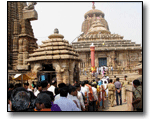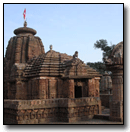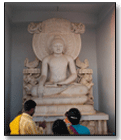Art and Culture
The population of Khurda consists mostly of Oriya & Telugu speaking people. Others like Muslims, Marwaris, Gujuratis, and Bengalis are also present in good numbers. There are a number of Temples, Masjids & Churches present here. This District is also the home of highest number of Anglo Indian people in Odisha. Khurda District is famous for its celebrations of the

Ganesh Chaturthi festival (in Jatni), Khurda Mohotsav (in Khurda Town) and Laxmi Puja. Eid ul Fitr & Christmas are also celebrated here with much gaiety, as also the other major Hindu festivals like Diwali and Holi. The firecracker shops in Jatani are very famous, drawing a large number of buyers from nearby places like Puri, Cuttack, etc. during Diwali. Padanpur is a village also famous for its crackers. Several weeklong festivals for the goddess Bhgabati Devi are celebrated here.On the last day of the festival, a procession is carried out in public, followed by a carnival depicting stories from Hindu mythologies like Ramayana, Mahabharata etc.Each community observes its festivals and also indulges in other communities celebrations, thus building communal harmony. Kaipadar is a religious place to which people of all faiths visit for divine blessings. Paika Nrutya dance of this District is a form of battle dance practiced with great enthusiasm by different groups in the villages during Dussera. The word Paika is derived from the Sanskrit word Padatika, literallys meaning infantry. This dance is more like a clarion call urging the dancers to get ready for a fiery battle ahead.Dholak, nagara, shehnai and dhak drums are the musical instruments which accompanies this dance.
Art
Bhubaneswar, the capital city of the state, at one point in time is supposed to have had over a thousand temples. Although a large number of these temples have given way for urban infrastructures, Bhubaneswar still abounds in temples of various deities. This has earned it the tag of the Temple City. The most famous ones are Lingaraj Temple, Lakshmanesvara group of temples, Parasuramesvara Temple, Svarnajalesvra Temple, Muktesvara Temple, Rajarani Temple, Vaital Temple, Brahmesvara Temple, Meghesvara Temple, Vaskaresvara Temple, Ananta Vasudeva Temple, Sari Temple, Kapilesvara Temple, Markandesvara Temple, Yamesvara Temple,Chitrakarini Temple and Sisiresvara Temple etc.
Apart from the ancient temples, few other important temples have been built in recent times that include Ram Mandir, ISKON etc.The Lingaraj Temple towers above the cityscape and is visible from far. Careful conservation has helped save many of these symbols of Oriya culture.
There has been a recent awareness towards preserving the ethos of Oriya culture in the form of classical Odissi dance, handicrafts, sand artistry, sculpturing as well as theater and music. Boundary walls and gardens are increasingly being redone to depict the folk art of the region.The Ekamra Haat is the popular handloom and handicrafts market that was constructed recently to popularise these products. Similarly SRJAN, the Odissi dance academy founded by Guru Kelucharan Mohapatra, the legendary Odissi dancer is located here.Rabindra Mandap, in central Bhubaneswar plays host to a number of cultural engagements and it also has a modern amphitheatre to host theatre and private functions.At Ratnagiri, Lalitgiri and Udaygiri (on the way to Paradip), Buddhist sites of great historical significance have been excavated. The site at Ratnagiri is the most extensive and the carvings and sculptures there are highly regarded for their proficiency and artistic merit.
Stone Carving

Stone carving is a major handicraft of Odisha. As is evident from the numerous archaeological monuments, rock cut sculptures, caves and temples built for centuries and embellished with most beautiful and carved statue and other adornments. The art of carving in stone had reached, in Odisha, dizzy heights of excellence perfected through centuries of disciplined efforts of generations of artisans.The progeny of these artisans built the magnificent temples of Parsurameswar, Mukteswar,Lingaraja, Jagannatha (also spelt as Jagannath) and that wonder in stone, the temple chariot of the Sun God at Konark. Besides, the beautiful stupas and monasteries of Lalitagiri, Ratnagiri and Udayagiri have kept alive the sculptural traditions of the sculptors forefathers.
Their skillful hands can do shapes and carve exact replicas of the original temple sculptures besides producing a variety of other items.Unlike sculptors of other places, the artisans of Odisha are at home with a variety of materials.
They handle with equal facility the ultra soft white soapstone, or Khadipathara, as the slightly harder greenish chlorite or Kochilapathara and the still harder pinkish Khandolite (Sahanapathara or Baulapathara) and the hardest of them all, the black granite or Mugunipathara. The tools that these artisans use are few and simple, consisting mainly of hammers and chisels of various shapes and sizes. These tools have local names such as, Muna, Patili,Martual, Thuk Thuki and Nihana. Whether the stone is hard or soft, a sort of outline is first drawn on the stone which has already been cut to the appropriate size beforehand.Once the outline is incised indicating the shape, the final figure is brought out by removing the unwanted portions. While for the harder stones this is done by chiseling out the extra material, with softer stones this is done by scraping out the same with a sharp flat edged iron tool. As for the motifs, the endless variety of sculptures adorning the temples provides the models, although other motifs are also not uncommon.
The Exquisite Embellishments

One may find samples of these in the Handicrafts museum, Bhubaneswar and in the Parliament House annexe in Delhi. Two samples are the Konark horse at the Barabati Stadium in Cuttack and Konark wheel of almost the same size as the original that adorns the face of a modern Hotel in Bhubaneswar. Another giant Konark horse adorns the traffic island at a busy junction in Bhubaneswar and will soon be a landmark.The four colossal Buddha images and the friezes depicting the life of Buddha and Ashoka at the modern Shanti Stupa in Dhauli are also the handiwork of Odisha’s craftsmen. Artisans mainly in Puri, Bhubaneswar, and Lalitgiri in Cuttack District practice the handicraft though some are also found in Khiching in Mayurbhanj District.
The traditions are carried on from generations and a few ancient texts on the art, which have survived, are closely followed.Apart from the decorative, votive articles and modern utilitarian items, the craft also covers another group of products, those in the shape of stoneware utensils and kitchen wares.Following the simple process of turning and polishing by using a local wooden lathe called Kunda, the craftsmen produce beautiful polished plates (Thali), containers (Gina, Pathuri), cups and glasses.These are used for pujas, ritual worships as well for regular eating. Pathuris, i.e. the stone ware deep containers are particularly good for storing curd as they do not react to acid. These are also filled with water and placed at the legs of wooden Almirahs to prevent ants from getting in. The craftsmen making these articles are concentrated at Baulagadia and Nilgiri.








